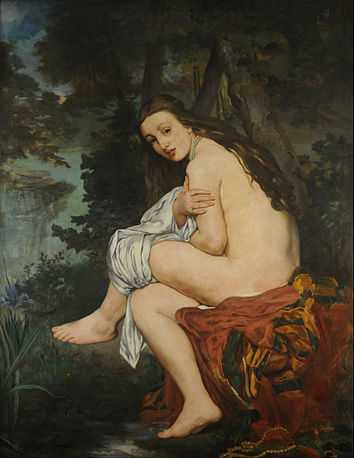La Nymphe surprise
 | |
| Artist | Édouard Manet |
|---|---|
| Year | 1861 |
| Type | Oil on canvas |
| Dimensions | 122 cm × 144 cm (48 in × 57 in) |
| Location | National Museum of Fine Arts in Buenos Aires, Buenos Aires |
La Nymphe surprise, or Nymph Surprised, is a painting by the French impressionist painter Édouard Manet, created in 1861. The model was Suzanne, a pianist and his secret beloved for years, whom he married two years later. The painting is a key work in Manet's production, marking the beginning of a new period in his artistic career and generally in the history of modernism in French painting. It is in National Museum of Fine Arts in Buenos Aires[1] and it is considered as one of the collection's highlights. Manet had special feelings for this painting, and La Nymphe surprise remained in the artist's possession his entire life, and there is evidence that points to the fact that, apart from the emotional significance it represented for the artist, Manet considered this painting as one of his most important works.[2][3][4]
History

The model of the painting is Édouard Manet's lover, who also was his piano teacher, the Dutch girl Suzanne Leenhoff, with whom he had a secret love affair. This love affair developed while the young Manet was still living in his parents' house. The girl was three years older than the 17-year-old Manet and their relationship was kept secret from his family for a long time. Manet and Suzanne married after ten years of love relationship in 1863,[5] two years after the completion of this painting in 1861.[1] The relationship lasted throughout their lives.[5][6]
Nymphs were female spirits of nature, female deities from Greek mythology, often depicted as young women, who dwell in mountains and small woods, by springs and rivers.[7] Several authors think that the motif is similar to Rembrandt's Susanna and the Elders, considering that the model's name is Suzanne, she was Dutch and the figure's pose is identical with the one in the painting. Manet kept this painting in his atelier. The painting was exhibited at the Salon des Artistes Français in 1865.[2] This painting was painted two years before the Le Déjeuner sur l'herbe (The Luncheon on the Grass) and Olympia.[8] The painting was purchased by the National Museum of Fine Arts in Buenos Aires and was placed on display at the Museum, as one of the institution's highlights.[9]
Painting
Manet's La Nymphe surprise depicts a young woman sitting in a wooded landscape beside a lake, looking surprised at the viewer. There is a blue iris growing at her feet, and she wears nothing on her body except the white pearls around her neck and a ring on her little finger. The nymph's glance, contrary to Olympia's provocative glance, is surprised and shy, as if she has found the viewer watching her, invading her privacy, disturbing her.[9][10]
See also
- Boy Carrying a Sword, depicting Manet's and Suzanne's son
- The Reading
- Luncheon in the Studio
- Impressionism
- Nana
References
- ↑ 1.0 1.1 "La Nymphe surprise". Google Cultural Institute. Retrieved 20 February 2015.
- ↑ 2.0 2.1 "the-collection-highlights". www.mnba.gob.ar.
- ↑ Willard Huntington Wright (1928). "Modern Painting, Its Tendency and Meaning". p. .
- ↑ Willard Huntington Wright (1928). "Modern Painting, Its Tendency and Meaning". p. .
- ↑ 5.0 5.1 "collection/the-collection-online". www.metmuseum.org. Archived from the original on 11 March 2015. Retrieved 2015.
- ↑ Davies, Serena (18 January 2015). "Did Manet have a secret son?". Daily Telegraph. Retrieved 20 February 2015.
- ↑ "Nymph". www.theoi.com. Retrieved 2015.
- ↑ "Impressionnisme Édouard Manet". www.aparences.net. Retrieved 2015.
- ↑ 9.0 9.1 Farwell, Beatrice (April 1975). "Manet's 'Nymphe Surprise'". The Burlington Magazine (The Burlington Magazine Publications Ltd.) 117 (865): 224–227, 229. JSTOR 877979.
- ↑ "History's roving eye turns to the femme fatale". www.buenosairesherald.com. Retrieved 2015.